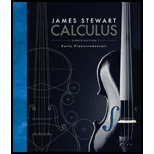
Concept explainers
(a) Write the general form of a second-order homogeneous linear differential equation with constant coefficients.
(b) Write the auxiliary equation.
(c) How do you use the roots of the auxiliary equation to solve the differential equation? Write the form of the solution for each of the three cases that can occur.
(a)
To write: The general form of a second-order homogeneous linear differential equation with constant coefficients.
Answer to Problem 1RCC
The general form of a second-order homogeneous linear differential equation with constant coefficients is
Explanation of Solution
Formula used:
Consider the second-order linear differential equation as follows.
Here,
If
Consider the value of
Substitute
Consider
Substitute
Thus, the general form of a second-order homogeneous linear differential equation with constant coefficients is
(b)
To write: The auxiliary equation.
Answer to Problem 1RCC
The auxiliary equation of the second-order differential equation is
Explanation of Solution
Modify equation (3) as follows.
In equation (4), function
Consider a exponential function for
Differentiate
Differentiate
Substitute
Since, the value of
Equation (6) is known as characteristic equation or auxiliary equation of the second-order differential equation
Thus, the auxiliary equation of the second-order differential equation is
(c)
To explain: The use of roots of the auxiliary equation to solve the differential equation and write the form of the solution for each of the three cases.
Answer to Problem 1RCC
The use of roots of the auxiliary equation to solve the differential equation is explained.
The form of the solution for each of the three cases is written.
Explanation of Solution
Formula used:
Consider the second-order differential equation as follows.
Write the expression for quadratic formula.
Modify equation (7) as follows.
Modify equation (8) as follows.
Thus, the use of roots of the auxiliary equation to solve the differential equation is explained.
Three different cases are obtained depending upon the term
Case I:
Consider the value of
In this case, the roots of auxiliary equation are real and distinct. So two linear independent solutions are occurs such as
Write the expression for general solution.
Here,
Substitute
Case II:
Consider the value of
In this case, the roots of auxiliary equation are real and equal.
Consider
Substitute
Case III:
Consider the value of
In this case, the roots of auxiliary equation are complex numbers.
Consider
Write the expression for general solution with complex roots.
Thus, the form of the solution for each of the three cases is written.
Want to see more full solutions like this?
Chapter 17 Solutions
Calculus: Early Transcendentals
Additional Math Textbook Solutions
Pathways To Math Literacy (looseleaf)
College Algebra Essentials (5th Edition)
College Algebra (Collegiate Math)
Intermediate Algebra (13th Edition)
APPLIED STAT.IN BUS.+ECONOMICS
Elementary Statistics Using The Ti-83/84 Plus Calculator, Books A La Carte Edition (5th Edition)
- I need help in ensuring that I explain it propleryy in the simplifest way as possiblearrow_forwardI need help making sure that I explain this part accutartly.arrow_forwardPlease help me with this question as I want to know how can I perform the partial fraction decompostion on this alebgric equation to find the time-domain of y(t)arrow_forward
- Please help me with this question as I want to know how can I perform the partial fraction on this alebgric equation to find the time-domain of y(t)arrow_forwardEvaluate F³ - dr where ♬ = (4z, -4y, x), and C' is given by (t) = (sin(t), t, cos(t)), 0≤t≤ñ .arrow_forwardMid-Term Review Find the formula for (f + g)(x). f(x) = x² - 10x + 25 and g(x) = x² - 10x + 24 (f + g) (x) = [ 2 ]x² X + DELL Skip Sarrow_forward
- Calculus III May I please have some elaborations on Example 2 part a? Thank you.arrow_forward1. A bicyclist is riding their bike along the Chicago Lakefront Trail. The velocity (in feet per second) of the bicyclist is recorded below. Use (a) Simpson's Rule, and (b) the Trapezoidal Rule to estimate the total distance the bicyclist traveled during the 8-second period. t 0 2 4 6 8 V 10 15 12 10 16 2. Find the midpoint rule approximation for (a) n = 4 +5 x²dx using n subintervals. 1° 2 (b) n = 8 36 32 28 36 32 28 24 24 20 20 16 16 12 8- 4 1 2 3 4 5 6 12 8 4 1 2 3 4 5 6arrow_forward= 5 37 A 4 8 0.5 06 9arrow_forward
- Consider the following system of equations, Ax=b : x+2y+3z - w = 2 2x4z2w = 3 -x+6y+17z7w = 0 -9x-2y+13z7w = -14 a. Find the solution to the system. Write it as a parametric equation. You can use a computer to do the row reduction. b. What is a geometric description of the solution? Explain how you know. c. Write the solution in vector form? d. What is the solution to the homogeneous system, Ax=0?arrow_forward2. Find a matrix A with the following qualities a. A is 3 x 3. b. The matrix A is not lower triangular and is not upper triangular. c. At least one value in each row is not a 1, 2,-1, -2, or 0 d. A is invertible.arrow_forwardFind the exact area inside r=2sin(2\theta ) and outside r=\sqrt(3)arrow_forward
 Calculus: Early TranscendentalsCalculusISBN:9781285741550Author:James StewartPublisher:Cengage Learning
Calculus: Early TranscendentalsCalculusISBN:9781285741550Author:James StewartPublisher:Cengage Learning Thomas' Calculus (14th Edition)CalculusISBN:9780134438986Author:Joel R. Hass, Christopher E. Heil, Maurice D. WeirPublisher:PEARSON
Thomas' Calculus (14th Edition)CalculusISBN:9780134438986Author:Joel R. Hass, Christopher E. Heil, Maurice D. WeirPublisher:PEARSON Calculus: Early Transcendentals (3rd Edition)CalculusISBN:9780134763644Author:William L. Briggs, Lyle Cochran, Bernard Gillett, Eric SchulzPublisher:PEARSON
Calculus: Early Transcendentals (3rd Edition)CalculusISBN:9780134763644Author:William L. Briggs, Lyle Cochran, Bernard Gillett, Eric SchulzPublisher:PEARSON Calculus: Early TranscendentalsCalculusISBN:9781319050740Author:Jon Rogawski, Colin Adams, Robert FranzosaPublisher:W. H. Freeman
Calculus: Early TranscendentalsCalculusISBN:9781319050740Author:Jon Rogawski, Colin Adams, Robert FranzosaPublisher:W. H. Freeman
 Calculus: Early Transcendental FunctionsCalculusISBN:9781337552516Author:Ron Larson, Bruce H. EdwardsPublisher:Cengage Learning
Calculus: Early Transcendental FunctionsCalculusISBN:9781337552516Author:Ron Larson, Bruce H. EdwardsPublisher:Cengage Learning





